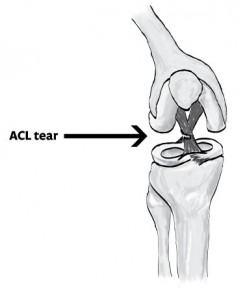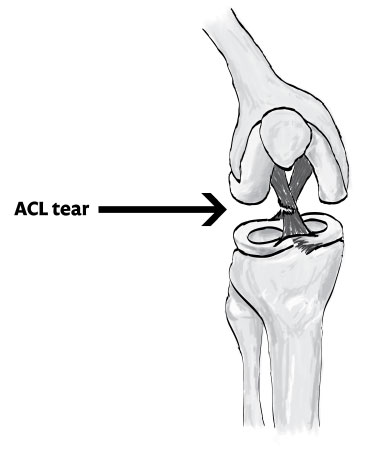When performing the intense and demanding activities that all athletes do, its no surprise that sometimes the body is unable to support all of the stress inflicted upon it. The most common athletic injuries can occur in a wide variety of sports, and one injury that is common to athletes who are running and changing directions quickly is the dreaded Anterior Cruciate Ligament (ACL) tear.
ACL tears occur most frequently to those participating in sports that involve a lot of running, like basketball, soccer, and football.
The anterior cruciate ligament is located inside the knee joint and controls the hinge movement of the knee. It runs diagonally and also helps to prevent the tibia or front shin bone from sliding out in front of the femur or thigh bone, as well as assists knee stabilization in rotational movements.
 Injuries to a ligament are considered sprains, and there are three levels of injury, from grade one, where there is only minor damage and the knee is still intact, to grade three, where the ligament has been torn completely in half and the knee is no longer stable.
Injuries to a ligament are considered sprains, and there are three levels of injury, from grade one, where there is only minor damage and the knee is still intact, to grade three, where the ligament has been torn completely in half and the knee is no longer stable.
Grade three injuries are the most common because partial tears are rare to the ACL. These injuries usually occur due to quick directional changes or direct pressure due to contact, in which the knee makes a large rotation for which it is unsuited.
The most common way that athletes become instantly aware of an ACL tear is a loud “pop” accompanied by a severe knee pain.
Weight-bearing and walking become difficult and the knee will begin to swell.
Renee Ridout, Varsity Blues fastpitch pitcher and Ontario Intercollegiate Women’s Fastpitch Association allstar, recently recovered from an ACL tear.
“I tore my ACL… two summers ago playing fastpitch,” she says.
“The recommended surgery with a hamstring graft, as that was the most common and most efficient for women, and that I get a hard brace for the mean time. I continued my Varsity Blues Fastpitch season that year (without an ACL) using my brace and I went to physio so that I could strengthen my muscles around my knee in preparation for surgery,” she describes.
The following November, Ridout had surgery on her knee. The operation was followed by two weeks on crutches and six months off of sports and other lateral movements. However, within two months, she was able to begin some running and workouts.
One side effect of this surgery and time off that surprised Ridout was the loss of muscle.
“At the six month mark I was back into sports full throttle. I tried my hardest to keep up with my exercises, but at six months I still didn’t feel my knee was as it used to be. Even today (one year and four months [later]) I still feel my knee will never be the same. I have moments of weakness and instability,” says Ridout.
While full recoveries are possible, it is uncommon for those who suffer from ACL tears to completely recover. There are a number of procedures that those who are injured can take to rehabilitate their knee that range from strengthening to invasive surgery.


